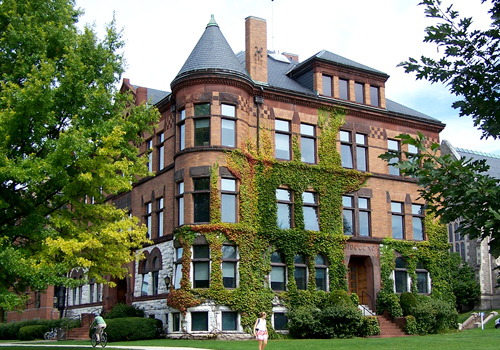Williams College
Williamstown, Massachusetts
12.6%
Admission Rate
Very Selective
2,028 Undergraduates Enrolled
- Private nonprofit
- Baccalaureate Colleges: Arts & Sciences Focus
- Four-year, full-time, more selective, lower transfer-in
- Four-year, small, highly residential

By Tim4403224246 - Own work, CC BY-SA 4.0, https://commons.wikimedia.org/w/index.php?curid=48566986
Williams College is a private liberal arts college in Williamstown, Massachusetts. It was established as a men's college in 1793 with funds from the estate of Ephraim Williams, a colonist from the Province of Massachusetts Bay who was killed in the French and Indian War in 1755. It is the second-oldest institution of higher education in the Commonwealth of Massachusetts after Harvard College.
Although the bequest from the estate of Ephraim Williams intended to establish a "free school", the exact meaning of which is ambiguous, the college quickly outgrew its initial ambitions. It positioned itself as a "Western counterpart" to Yale and Harvard. It became officially coeducational in the 1960s.
Williams's main campus is located in Williamstown, in the Berkshires in rural northwestern Massachusetts, and contains more than 100 academic, athletic, and residential buildings. There are 319 voting faculty members, with a student-to-faculty ratio of 6:1. As of 2021, the school has an enrollment of 1,962 undergraduate students and 25 graduate students.
Following a liberal arts curriculum, Williams College provides undergraduate instruction in 25 academic departments and interdisciplinary programs including 36 majors in the humanities, arts, social sciences, and natural sciences. Williams offers an almost entirely undergraduate instruction, though there are two graduate programs in development economics and art history. The college maintains affiliations with the nearby Clark Art Institute and Massachusetts Museum of Contemporary Art, and has a close relationship with Exeter College, Oxford University. The college competes in the NCAA Division III New England Small College Athletic Conference as the Ephs. The athletic program has been highly successful, as Williams College has won 22 of the last 24 College Directors' Cups for NCAA Division III.Williams is a highly selective school with an acceptance rate of 8% for the Class of 2025. It has ranked first in U.S. News & World Report's rankings of National Liberal Arts Colleges every year since 2004, and the college has held high-ranking positions in other institutional rankings.
The college has many prominent alumni, including 9 Pulitzer Prize winners, a Nobel Prize Laureate, a Fields medalist, 3 chairmen of the U.S. Securities and Exchange Commission, a chairwoman of the Federal Trade Commission, 14 billionaire alumni, 71 members of the United States Congress, 22 U.S. Governors, 4 U.S. Cabinet secretaries, an Associate Justice of the Supreme Court, a President of the United States, 3 prime ministers, CEOs and founders of Fortune 500 companies, high-ranking U.S. diplomats, foreign central bankers, scholars in academia, literary and media figures, numerous Emmy, Oscar, and Grammy award winners, and professional athletes. Other notable alumni include 40 Rhodes Scholars and 17 Marshall Scholarship winners.
"Williams College." Wikipedia, Wikimedia Foundation, 15 February 2022, https://en.wikipedia.org/wiki/Williams_College.
Although the bequest from the estate of Ephraim Williams intended to establish a "free school", the exact meaning of which is ambiguous, the college quickly outgrew its initial ambitions. It positioned itself as a "Western counterpart" to Yale and Harvard. It became officially coeducational in the 1960s.
Williams's main campus is located in Williamstown, in the Berkshires in rural northwestern Massachusetts, and contains more than 100 academic, athletic, and residential buildings. There are 319 voting faculty members, with a student-to-faculty ratio of 6:1. As of 2021, the school has an enrollment of 1,962 undergraduate students and 25 graduate students.
Following a liberal arts curriculum, Williams College provides undergraduate instruction in 25 academic departments and interdisciplinary programs including 36 majors in the humanities, arts, social sciences, and natural sciences. Williams offers an almost entirely undergraduate instruction, though there are two graduate programs in development economics and art history. The college maintains affiliations with the nearby Clark Art Institute and Massachusetts Museum of Contemporary Art, and has a close relationship with Exeter College, Oxford University. The college competes in the NCAA Division III New England Small College Athletic Conference as the Ephs. The athletic program has been highly successful, as Williams College has won 22 of the last 24 College Directors' Cups for NCAA Division III.Williams is a highly selective school with an acceptance rate of 8% for the Class of 2025. It has ranked first in U.S. News & World Report's rankings of National Liberal Arts Colleges every year since 2004, and the college has held high-ranking positions in other institutional rankings.
The college has many prominent alumni, including 9 Pulitzer Prize winners, a Nobel Prize Laureate, a Fields medalist, 3 chairmen of the U.S. Securities and Exchange Commission, a chairwoman of the Federal Trade Commission, 14 billionaire alumni, 71 members of the United States Congress, 22 U.S. Governors, 4 U.S. Cabinet secretaries, an Associate Justice of the Supreme Court, a President of the United States, 3 prime ministers, CEOs and founders of Fortune 500 companies, high-ranking U.S. diplomats, foreign central bankers, scholars in academia, literary and media figures, numerous Emmy, Oscar, and Grammy award winners, and professional athletes. Other notable alumni include 40 Rhodes Scholars and 17 Marshall Scholarship winners.
"Williams College." Wikipedia, Wikimedia Foundation, 15 February 2022, https://en.wikipedia.org/wiki/Williams_College.
Location
City
Williamstown, Massachusetts
Locale
Town: Fringe (in urban cluster up to 10 miles from an urbanized area)
Region
New England (CT, ME, MA, NH, RI, VT)
Academics
Predominant Degree Awarded
Predominantly bachelor's-degree granting
Highest Degree Awarded
Graduate degree
Most Popular Fields
| Field | % Students |
|---|---|
| Social Sciences | 29.0% |
| Biological And Biomedical Sciences | 10.2% |
| Physical Sciences | 9.2% |
| English Language And Literature/Letters | 8.0% |
| Computer And Information Sciences And Support Services | 7.2% |
| History | 6.7% |
| Psychology | 5.7% |
| Foreign Languages, Literatures, And Linguistics | 5.7% |
| Visual And Performing Arts | 5.5% |
| Mathematics And Statistics | 4.9% |
| Area, Ethnic, Cultural, Gender, And Group Studies | 4.9% |
| Philosophy And Religious Studies | 1.8% |
| Natural Resources And Conservation | 1.0% |
| Multi/Interdisciplinary Studies | 0.4% |
Cost
Tuition
$57,280.00
Percentage Students Receiving Aid
21.90%
Average Net Cost After Aid
$19,480.00
Admissions
SAT Scores
1488
Composite Average
| Percentile | 75% | 50% | 25% |
|---|---|---|---|
| Math | 790 | 750 | 710 |
| Verbal | 760 | 730 | 700 |
ACT Scores
34
Cumulative Average
| Percentile | 75% | 50% | 25% |
|---|---|---|---|
| Math | 35 | 33 | 30 |
| English | 36 | 35 | 34 |
 Top 25 Colleges
Top 25 Colleges